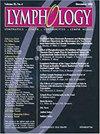淋巴水肿吸脂手术会加重淋巴损伤吗?
IF 0.7
4区 医学
Q4 IMMUNOLOGY
引用次数: 0
摘要
抽脂治疗淋巴水肿是一种行之有效、久经考验的治疗方法。然而,由于人们担心吸脂会造成进一步的淋巴损伤,我们对吸脂前后的淋巴功能进行了客观比较。研究纳入了在2014年6月至2018年11月期间接受治疗的所有实性淋巴水肿患者。使用患者报告的基线/结果、淋巴水肿特定生活质量量表(LYMQOL)、肢体周长/体积测量值和吲哚菁绿淋巴造影(ICGL)对患者进行术前评估,并在术后预定的时间间隔进行评估。共纳入了 41 名患者的 57 个肢体。手臂、大腿和小腿的平均吸脂量分别为 2035 mL、5385 mL 和 3106 mL,吸脂量中脂肪的平均比例为 71%。所有患者都接受了 "飞鼠 "技术的多余皮肤切除术。平均随访时间为 10.7 个月(3 - 48 个月),平均肢体体积缩小了 32.2%,所有患者都表示症状得到了满意的缓解。所有患者的 LYMQOL 在症状、外观和功能方面均有明显改善。在 ICGL 检查中,所有患者的淋巴引流情况都没有恶化,反而都有所改善。此外,在研究期间,所有患者的淋巴引流情况都在逐渐改善。我们的研究结果表明,用吸脂术治疗肢端淋巴水肿并不会使淋巴功能恶化,事实上,矛盾的是,它还能诱导淋巴引流的逐步改善。本文章由计算机程序翻译,如有差异,请以英文原文为准。
Does Liposuction for Lymphedema Worsen Lymphatic Injury?
Liposuction for treatment of lymphedema is an effective and time-tested treatment. However, as there is a fear regarding further lymphatic damage caused by liposuction, we objectively compared lymphatic function pre- and post-liposuction. All patients with solid-predominant lymphedema who were treated during the study period of June 2014 and November 2018 were included. Patients were assessed using patient-reported baselines/outcomes, lymphedema- specific quality of life scale (LYMQOL), limb circumference/volume measurements, and indocyanine green lymphography (ICGL) preoperatively and at predefined postoperative time intervals. Fifty-seven limbs from 41 patients were included. Mean lipoaspirate volumes were 2035 mL, 5385 mL, and 3106 mL for the arm, thigh, and leg, respectively with a mean adipose fraction of the lipoaspirate of 71%. All patients underwent redundant skin excision with the "flying squirrel" technique. The mean follow-up was 10.7 months (range 3 - 48 months) with a mean limb volume reduction of 32.2% and all patients reporting satisfactory relief of symptoms. All showed statistically significant improvement in LYMQOL in symptoms, appearance, and function. On ICGL, none showed worsened lymphatic drainage, rather, all showed improved lymph drainage. Furthermore, the improved lymph drainage was found to be progressive during the study period in all patients. Our study results demonstrate that treating extremity lymphedema with liposuction does not worsen lymphatic function and in fact, paradoxically, it induces progressive improvement in lymph drainage.
求助全文
通过发布文献求助,成功后即可免费获取论文全文。
去求助
来源期刊

Lymphology
医学-免疫学
CiteScore
5.20
自引率
8.00%
发文量
29
审稿时长
3 months
期刊介绍:
The Journal contains original articles, special features (see below), and information regarding the International Society of Lymphology. It seeks original papers dealing with clinical and basic studies of the lymphatic system and its disorders including related fields. Articles are accepted for external review and publication on the condition that they are contributed to Lymphology only and that no substantial part has been or will be published elsewhere.
 求助内容:
求助内容: 应助结果提醒方式:
应助结果提醒方式:


